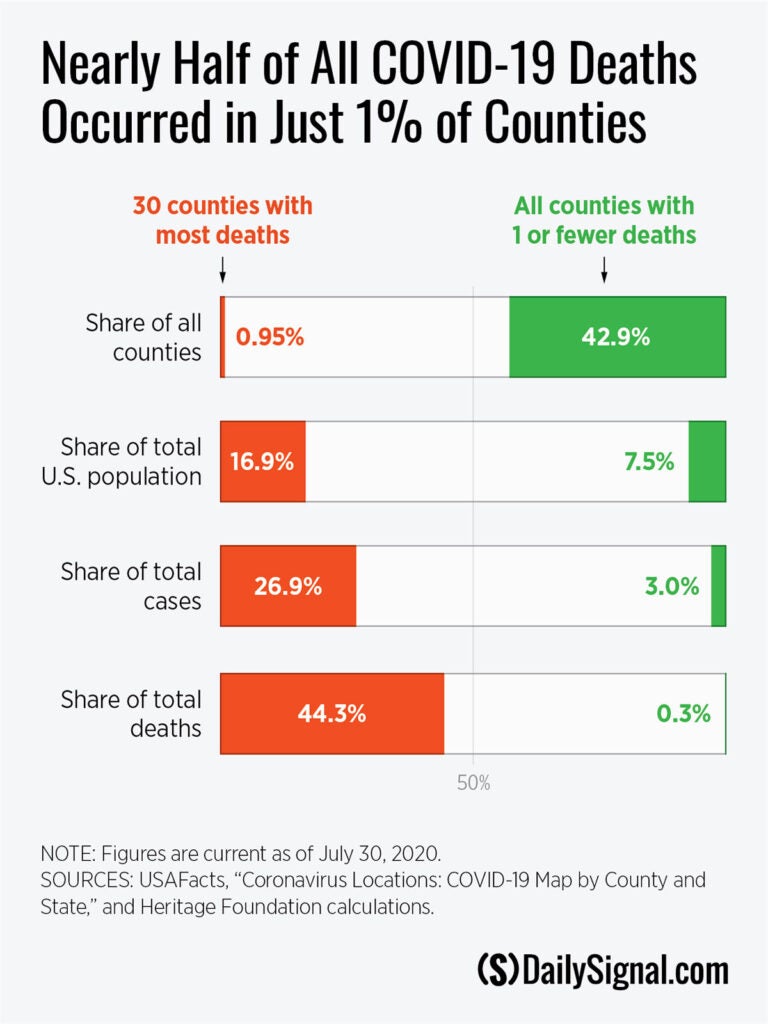As Heritage Foundation researchers have demonstrated throughout the coronavirus pandemic, the spread of COVID-19 in the U.S. has been heavily concentrated in a small number of states—and among a small number of counties within states.
Even though the U.S. has seen a rapid rise in cases during the past month, the overall levels of concentration have remained fairly consistent.
As of July 28, for example, just 10 states account for 60% of all U.S. cases and 68% of all deaths (greater than their 50% share of the population).
>>> What’s the best way for America to reopen and return to business? The National Coronavirus Recovery Commission, a project of The Heritage Foundation, assembled America’s top thinkers to figure that out. So far, it has made more than 260 recommendations. Learn more here.
The five states with the most cases—New York, California, Florida, Texas, and New Jersey—report 44% of all U.S. cases and 46% of all deaths.
In the past 30 days, the five states with the most reported COVID-19 deaths is very similar—Texas, California, Florida, Arizona, and New York (in descending order). Together, these five states reported 52% of all the COVID-19 deaths during the past 30 days, although they account for 36% of the U.S. population.
For comparison, Texas reported approximately 3,500 COVID-19 deaths over the past 30 days. In April and May, New York reported the most COVID-19 deaths—about 21,000 in April and 6,200 in May—as situations began to improve in the state.
Together, New York and New Jersey alone account for 31% of all COVID-19 deaths, though they include only 9% of the U.S. population. Those two states reported 9% of the COVID-19 deaths in the past 30 days.
These state-level figures do not, however, adequately describe the concentrated nature of the spread of COVID-19.
The 30 counties with the most COVID-19 deaths, for example, account for 28% of all the cases in the U.S. and 46% of all deaths, much greater than their 17% share of the U.S. population. That is, just 1% of the counties in the U.S., representing 17% of the U.S. population, are responsible for almost half of the country’s COVID-19 deaths.
Of those 30 counties, 23 are in the Northeast corridor between Philadelphia and Boston, the passageway served by a commuter railway system that runs through Manhattan.
Overall, only about 10% of the counties in the U.S. contain 90% of all the COVID-19 deaths, even though those counties include 60% of the population.
Throughout the pandemic, there have been many U.S. counties with relatively few COVID-19 deaths. For instance, as of May 11, 64% of all counties (16% of the U.S. population) had one or no COVID-19 deaths. As of July 28, 43% of all counties (8% of the population) have no more than one COVID-19 death each.
While these numbers have obviously declined since May, many counties still have a relatively small number of COVID-19 deaths. In particular, as of July 28, 63% of all counties (16% of the population) have five or fewer COVID-19 deaths.
In the past 30 days, the 30 counties with the most COVID-19 deaths account for 39% of the COVID-19 deaths reported in the U.S., almost double their population share of 21%.
Now that COVID-19 testing has dramatically increased and many state and local governments have relaxed stay-at-home orders, it is even more critical to study the trends in deaths along with cases.
To make studying these trends easier, The Heritage Foundation now has two interactive COVID-19 trackers. One tracks trends in cases, while the other tracks trends in deaths.

The trackers describe whether the trend of cases—or deaths—is increasing or decreasing over the prior 14 days, and provides a visual depiction of new cases—or deaths—during that time period.
These tools help put the concentrated nature of the pandemic in perspective with county-level data, and they show just how difficult it can be to use only one metric to gauge whether a county—or state—is doing well.
For instance, on July 14, Harris County in Texas had 2,001 new cases, the most of the previous two-week period. However, the number of cases then trended down for the next 14 days. While the number of deaths has increased as well, an unusually large number was reported on July 27.
Readers are invited to explore the information in the tracker and check back frequently for updates, as well as explore the other visual tools on Heritage’s COVID-19 resources page.





























